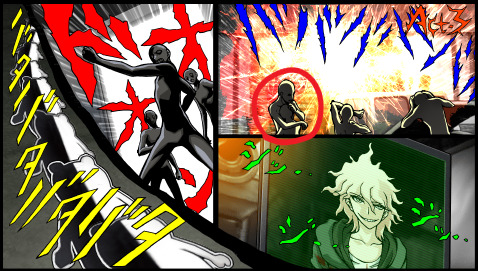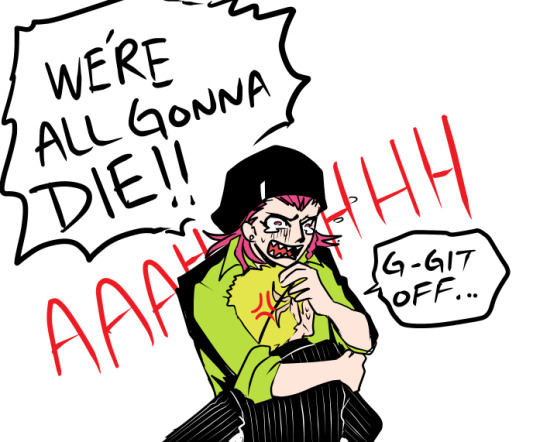Text
In Japanese, everyone’s “Here’s our answer!” from V3 is different. I have some notes explaining their differences in speech. Very long post.
General Sentence Structure: “This is our answer!”
これ (kore) = This
が (ga) = Is
[First Person Pronoun] = I
達 or たち (tachi) = When placed after one’s pronoun, it turns “I” into “we”.
の (no) = This is a particle showing possession. It basically changes “we” into “our”.
答え (kotae) = Answer
After that, there will be particles showing inflection, which show tone and pitch. I’ll explain more for individual characters.
っ = This is called a sokuon, and doesn’t have a pronunciation by itself, it repeats a consonant following it. For example, か is ka, so っか is kka. な is na, so っな is nna. You’ll notice when it’s used here, nothing follows after. When nothing comes after, the particle was meant as a glottal stop, meaning a sound created by quickly closing and opening the vocal cords to forcefully release lung air. If you still don’t get it, it’s basically just how the sentence was said, rather than having a translation as a word.
Kaede: これが私達の答えだよっ! Romanized: Kore ga Watashi-tachi no kotae dayo!
Kaede uses the first person pronoun “Watashi”, written in Kanji. It can be used formally and informally, but usually only women use it informally. She ends her sentence with “dayo”. Da is considered informal and impolite, but the addition of Yo adds a gentler connotation as well as confidence.
Miu: これがオレ様達の答えだぜっ! Romanized: Kore ga Oresama-tachi no kotae daze!
Miu uses the first person pronoun “Ore” written in Katakana, making it seem more blunt. It’s a more masculine pronoun and can sound impolite in some cases. She also adds the honorific “sama”, which adds superiority. She ends her sentence with “daze”. Like before, da is impolite and Ze adds emphasis. Miu has a very blunt and rude way of speaking. Her speech comes across as masculine, since women are expected to speak more politely.
Angie: これがアンジー達の答えだよー! Romanized: Kore ga Angie-tachi no kotae dayooo!
Angie uses her own name as a first person pronoun, essentially referring to herself in third person. This makes her seem cuter and less intimidating. Like Kaede, she ends she sentence in “dayo”, but instead of っ she uses ー, which extends the sound. It makes her seem more cheerful and friendly.
Tsumugi: これがわたし達の答えだよっ! Romanized: Kore ga Watashi-tachi no kotae dayo!
Tsumugi uses the first person pronoun “Watashi”, but uses Hiragana instead of Kanji. In this case Hiragana gives a bit of a softer impression that Kanji does. The ending of her sentence is the same as Kaede.
Tenko: これが転子達の答えですっ! Romanized: Kore ga Tenko-tachi no kotae desu!
Tenko uses her name as her first person pronoun, like Angie. Referring to yourself with your own name is also considered feminine and childish. She ends her sentence in “desu”, which gives a polite impression. It’s understandable as to why someone with Tenko’s beliefs would use more polite language, as it’s associated with femininity.
Maki: これが私達の答えだっ! Romanized: Kore ga Watashi-tachi no kotae da!
Maki uses the first person pronoun “Watashi” in Kanji, like Kaede. Her sentence structure is the same, except she ends in “da” rather than “dayo”. Just using da gives an impolite impression, which someone like Maki would not really care about.
Himiko: これがウチらの答えじゃっ! Romanized: Kore ga Uchira no kotae ja!
Himiko uses the first person pronoun “Uchi”. This is an informal feminine pronoun that’s usually used in more western areas of Japan. She also uses ら instead of 達, but they serve the same purpose. She ends her sentence with “Ja”. It is the same as “da”, but is a different dialect, similar to her first person pronoun.
Kirumi: これが私達の答えよっ! Romanized: Kore ga Watashi-tachi no kotae yo!
Kirumi uses the first person pronoun “Watashi” in Kanji, as it is considered formal as well as informal. She ends her sentence with just “yo”. Similarly to how Kaede used “yo” to make “da” less impolite, Kirumi removes “da” completely. As a maid, she speaks very politely but still confidently.
Kiibo: これがボクたちの答えですっ! Romanized: Kore ga Boku-tachi no kotae desu!
Kiibo uses the first person pronoun “Boku” in Katakana. It’s a polite masculine pronoun, but some women use it. Using Katakana rather than Kanji gives a younger impression, the person writing it is likely a teenager or below, since adults usually use Kanji. Note that Makoto and Nagito use this as well. You’ll notice some boys use たち instead of 達, but it’s the same, if not very slightly more informal. He ends his sentence in “desu”, as Kiibo is very polite and often speaks formally.
Korekiyo: これが僕達の答えだヨ…! Romanized: Kore ga Boku-tachi no kotae dayo...!
Korekiyo uses the first person pronoun “Boku” in Kanji, giving a more mature impression than if in Katakana. He ends his sentence with “dayo” like Kaede, but uses the Katakana form of Yo rather than the typical Hiragana form. This is a quirk Korekiyo has, if his sentence ends in Hiragana, it will be written with Katakana instead. I don’t think there is a specific reason, it’s just to make his language a bit more unique. I assume it ends in an ellipsis because he’s creepy…
Kokichi: これがオレたちの答えだよっ! Romanized: Kore ga Ore-tachi no kotae dayo!
Kokichi uses the first person pronoun “Ore” in Katakana. Like Miu, it’s masculine and blunt. However, in Kokichi’s case, it may come off as childish. He ends in sentence in “dayo”, same as Kaede.
Gonta: これがゴン太たちの答えだよっ! Romanized: Kore ga Gonta-tachi no kotae dayo!
Gonta uses the first person pronoun of his own name. This is considered childish, and, past childhood, it’s feminine. Gonta is neither of these things, so I believe it to be a habit he never grew out of, or just to emphasize him growing up in the wilderness. His sentence ends in “dayo”, like Kaede.
Ryoma: これが俺達の答えだ…! Romanized: Kore ga Ore-tachi no kotae da…!
Ryoma uses the first person pronoun “Ore”, in Kanji. Like “Boku”, using the Kanji of Ore seems more mature than the Katakana form. He ends his sentence in “da” and an ellipsis. Unlike Korekiyo, it’s not creepy, it just makes him sound less energetic.
Kaito: これがオレ達の答えだっ! Romanized: Kore ga Ore-tachi no kotae da!
Kaito’s first person pronoun is “Ore” in Katakana, masculine and blunt. He ends his sentence with “da” only, which reaffirms his blunt and masculine manner of speech.
Shuichi: これが僕たちの答えだっ! Romanized: Kore ga Boku-tachi no kotae da!
Shuichi’s first person pronoun is “Boku” in Kanji, masculine and mature. He ends his sentence is “da”, which may seem impolite, but since he’s a boy, it comes off more normal.
Rantaro died before any trials, so we never got to here him say these words. However, here’s what I think he would say:
Rantaro: これが俺達の答えっすよっ! Romanized: Kore ga Ore-tachi no kotaessuyo!
Rantaro uses the first person pronoun “Ore” in Kanji and when saying “we”, he uses the Kanji form of tachi. Rantaro uses “ssu” or “ssuyo” in place of words like “da” or “dayo”. It is not as polite as desu, but it’s not considered impolite, it’s somewhat of a middle ground. It is also mostly used among young men. I think he would have the sokuon, as his speech is relaxed, but he takes things like the killing game very seriously.
How it felt to finish this then remember nobody gaf:

166 notes
·
View notes
Text
Hiyoko’s likes are listed as “Squish squishy” in English, but in Japanese it’s “Puchi puchi”, which means bubble wrap.
40 notes
·
View notes
Text


You can actually see Maki's eyes in all the sprites with shadows if the picture has no temperature.
496 notes
·
View notes
Text
Daily Danganronpa Fun Fact #351
The original pitch for Danganronpa V3 was going to be set in a desert with an American theme. However, Kodaka was never serious about it and just used it to get the concept of V3 approved.

Home | Previous Fact | Next Fact
193 notes
·
View notes
Text



After nearly a year, my nutcracker Ishimaru is finally finished! A handsomely ugly fellow fit to go on a rat-killing adventure with!
285 notes
·
View notes
Text

this image is so fucking funny to me. his ass is so stoned beyond belief. is he even aware hes here.
778 notes
·
View notes
Text

i love this CG because it's like

makoto is really working some Evil through his body here. that's this expression. there is something Foul within him that only high school PE can purify
130 notes
·
View notes
Text
Daily Danganronpa Fun Fact #330
Today is Danganronpa’s 14th Anniversary!
Danganronpa’s release date is a reference to Mukuro and Junko. In Japan, 11/25 is known as “good twins day”. 1 can be read as “i”, and two ones as “ii”, which means good. 2 can be read as “futa” and 5 as “go”, “futago” meaning twins.

Home | Previous Fact | Next Fact
312 notes
·
View notes
















